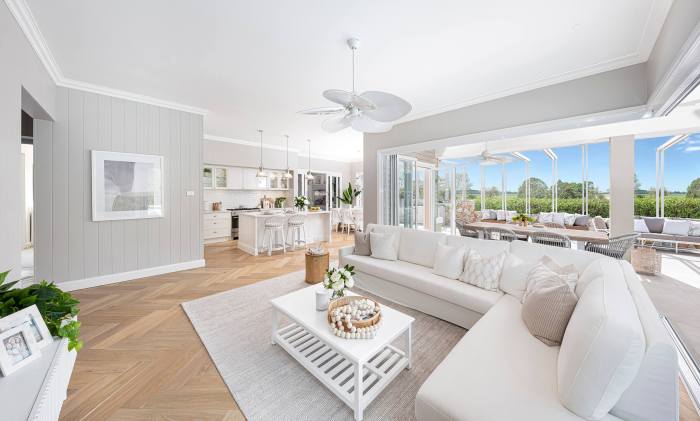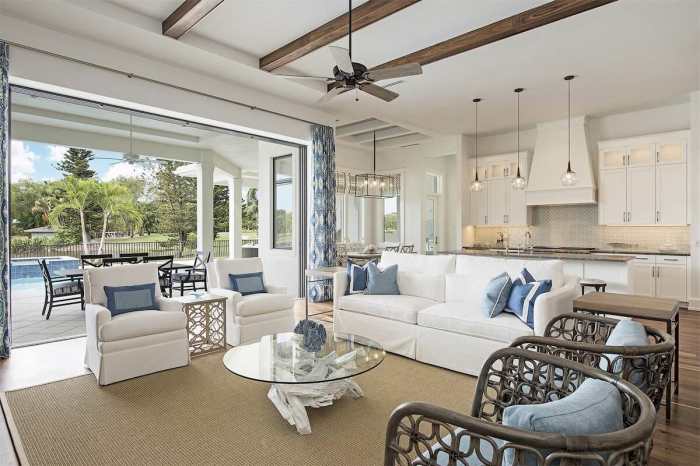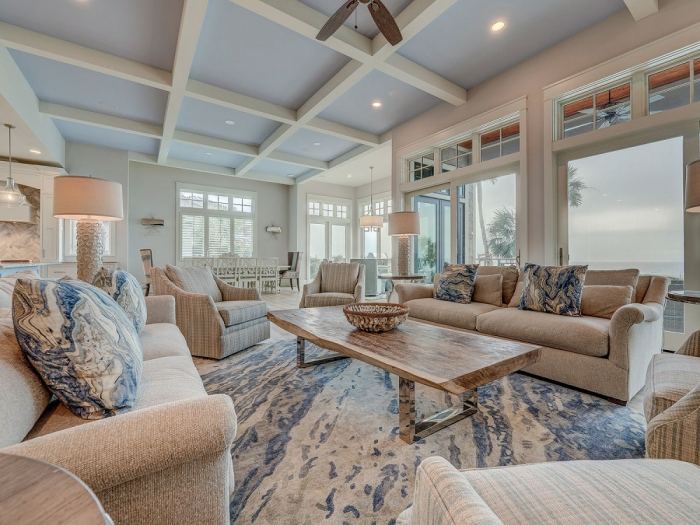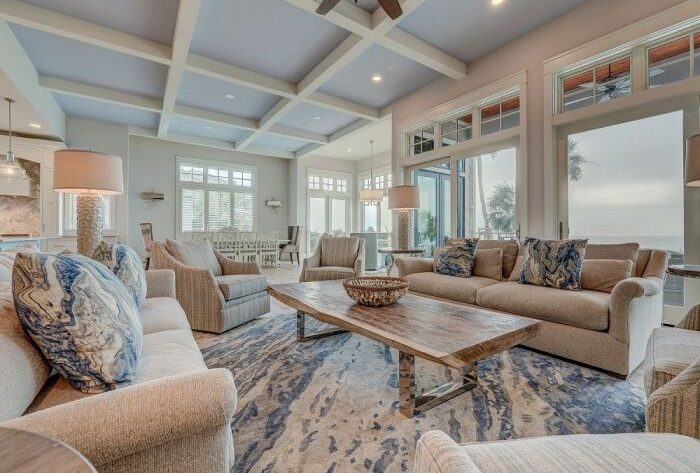Coastal house interior design evokes a sense of tranquility and effortless elegance, bringing the serenity of the seaside into your home. This style embraces a harmonious blend of natural elements, calming color palettes, and relaxed yet sophisticated furnishings, creating a space that feels both welcoming and invigorating.
From the soft hues of the ocean to the warmth of sun-bleached wood, every aspect of coastal design reflects the beauty of the natural world. Imagine stepping into a space where light streams through expansive windows, illuminating airy rooms adorned with driftwood accents and woven textures.
The air is filled with the scent of sea salt and the gentle sound of waves crashing on the shore, transporting you to a peaceful haven.
Textiles and Fabrics

Coastal-inspired interior design often incorporates textiles and fabrics that evoke a sense of relaxation, tranquility, and the natural beauty of the seaside. These materials play a crucial role in creating a welcoming and inviting atmosphere.
Coastal-Inspired Textiles and Fabrics
Coastal-inspired textiles and fabrics are characterized by their natural textures, light colors, and breezy patterns. These materials create a sense of airiness and freshness, reminiscent of the ocean breeze and sandy beaches. Here are some examples:
- Linen: Linen is a natural fiber known for its durability, breathability, and relaxed texture. Its light color and slightly rough texture evoke a sense of casual elegance, making it a popular choice for coastal-themed interiors. Linen curtains, throws, and upholstery fabrics create a relaxed and airy atmosphere.
- Cotton: Cotton is another natural fiber that is soft, breathable, and easy to care for. Its versatility makes it suitable for a wide range of applications, from bed linens and towels to curtains and upholstery. Cotton fabrics with nautical stripes, floral patterns, or subtle textures are ideal for coastal-themed interiors.
Coastal house interior design often evokes a sense of relaxation and tranquility, drawing inspiration from the surrounding ocean and natural elements. A similar aesthetic can be found in amakan house interior design , which emphasizes the use of natural materials and traditional craftsmanship.
Both styles prioritize a connection to nature, creating spaces that are both inviting and harmonious.
- Jute: Jute is a natural fiber known for its strength and durability. It is often used in rugs and wall coverings to create a natural and earthy feel. Jute’s rough texture adds a touch of rustic charm to coastal-themed interiors.
Coastal house interior design often evokes a sense of tranquility and connection to nature. The use of light, airy colors and natural materials like wood and rattan creates a relaxed and welcoming atmosphere. While achieving this aesthetic can sometimes be costly, there are ways to incorporate these elements on a budget, drawing inspiration from the principles of affordable housing interior design.
Clever use of DIY projects, repurposed furniture, and affordable paint colors can bring the coastal vibe to life without breaking the bank. Ultimately, coastal house interior design is about creating a space that feels both inviting and serene, regardless of budget.
- Hemp: Hemp is a natural fiber that is strong, durable, and eco-friendly. It is often used in rugs, curtains, and upholstery fabrics. Hemp’s natural texture and earthy tones add a touch of rustic charm to coastal-themed interiors.
- Seagrass: Seagrass is a natural fiber that is often used in rugs and wall coverings. Its natural texture and earthy tones add a touch of rustic charm to coastal-themed interiors. Seagrass is a sustainable and eco-friendly material that is perfect for creating a relaxed and natural atmosphere.
Coastal-Themed Dining Room
To design a coastal-themed dining room, consider using a combination of textiles and fabrics that evoke the feeling of the seaside. For example, you could use linen tablecloths and napkins with a subtle nautical stripe pattern. The chairs could be upholstered in cotton fabric with a light blue or white hue, and the windows could be adorned with linen curtains in a natural white or beige color.
Adding a jute rug with a subtle texture and a seagrass wall covering can further enhance the coastal theme. The use of natural elements such as driftwood, seashells, and coral can create a more authentic and inviting atmosphere.
Outdoor Living Spaces: Coastal House Interior Design

In coastal homes, blurring the lines between indoor and outdoor living is not just a design choice, but a way of life. The ocean breeze, the sounds of waves crashing, and the warmth of the sun all beckon residents to spend time outdoors.
Seamlessly integrating indoor and outdoor spaces creates a sense of flow and connection with nature, enhancing the overall living experience.
Designing a Coastal Patio
A coastal-inspired patio should reflect the relaxed, inviting atmosphere of the seaside. Here are some key elements to consider:
- Comfortable Seating:Choose furniture made from weather-resistant materials like wicker, teak, or aluminum. Oversized sofas, armchairs, and ottomans create a welcoming and spacious ambiance. Add pops of color with vibrant cushions and throws, drawing inspiration from the hues of the ocean, sand, and sky.
- Outdoor Lighting:Soft, ambient lighting is essential for creating a warm and inviting atmosphere. String lights, lanterns, and sconces can be used to illuminate the space, casting a gentle glow over the patio. Consider using solar-powered options for a sustainable and eco-friendly approach.
- Lush Greenery:Plants and flowers add life and vibrancy to the outdoor space. Choose species that thrive in coastal climates, such as succulents, palms, and flowering shrubs. Create a sense of privacy and tranquility by incorporating trellises and hedges.
Coastal House Interior Design Styles

Coastal design styles capture the essence of seaside living, bringing the tranquility and beauty of the ocean indoors. They often feature natural materials, light and airy color palettes, and a relaxed, inviting atmosphere.
Coastal house interior design often embraces a relaxed, airy feel, with light colors and natural textures. The use of space is key, especially in smaller homes. For larger homes, a bi-level design can be a great way to create distinct living areas, such as a formal living room on the upper level and a more casual family room on the lower level.
Bi level house interior design offers flexibility, and when combined with coastal elements like driftwood accents and nautical-inspired art, can create a truly unique and inviting home.
Hamptons Style, Coastal house interior design
The Hamptons style is a classic coastal design that originated in the Hamptons, a wealthy seaside area on Long Island, New York. It’s characterized by its sophisticated elegance and timeless appeal.
- Color Palette:The Hamptons style typically features a neutral color palette of white, cream, gray, and blue, often with pops of bright color in accessories.
- Materials:Natural materials such as wood, linen, and cotton are favored. Think weathered wood floors, whitewashed furniture, and linen drapes.
- Furniture:Hamptons style furniture is often sleek and simple, with clean lines and a focus on comfort. Slipcovered sofas, wicker chairs, and farmhouse tables are common elements.
- Decor:Nautical accents like seashells, rope, and maps add a touch of coastal charm. Fresh flowers and plants bring a touch of nature indoors.
California Coastal Style
The California Coastal style embodies the laid-back and casual lifestyle of the West Coast. It’s known for its relaxed vibe and its use of natural elements.
- Color Palette:The California Coastal style features a bright and airy color palette, often incorporating shades of blue, green, and yellow. White is a popular choice for walls and furniture, creating a sense of space and light.
- Materials:Natural materials like wood, stone, and rattan are favored. Reclaimed wood, driftwood, and woven baskets are common decorative elements.
- Furniture:Furniture is typically comfortable and casual, with a focus on functionality. Think oversized sofas, comfy armchairs, and outdoor dining sets.
- Decor:California Coastal decor often features natural elements like seashells, coral, and driftwood. Plants and succulents add a touch of greenery.
Scandinavian Coastal Style
Scandinavian Coastal style blends the minimalist aesthetic of Scandinavian design with the relaxed charm of coastal living. It’s characterized by its simplicity, functionality, and natural beauty.
- Color Palette:The Scandinavian Coastal style features a neutral color palette, often incorporating shades of white, gray, and blue. Natural wood tones and pops of color are used sparingly.
- Materials:Natural materials like wood, wool, and cotton are favored. Light wood floors, woven rugs, and linen curtains are common elements.
- Furniture:Furniture is typically simple and functional, with clean lines and a focus on comfort. Think sleek sofas, comfortable chairs, and simple tables.
- Decor:Scandinavian Coastal decor often features natural elements like driftwood, shells, and stones. Plants and succulents add a touch of greenery.
Epilogue
Creating a coastal house interior is more than just decorating; it’s about capturing the essence of a lifestyle. It’s about embracing the simplicity and beauty of nature, incorporating sustainable practices, and crafting a space that reflects your love for the seaside.
Whether you live by the coast or simply dream of its allure, coastal design offers a timeless and inspiring way to create a home that feels both serene and invigorating.
Clarifying Questions
What are the most popular coastal color palettes?
Popular coastal color palettes often incorporate shades of blue, green, white, and beige, drawing inspiration from the ocean, sky, and sand. Think soft blues, seafoam greens, crisp whites, and warm beiges, often accented with pops of coral or turquoise.
How can I incorporate natural elements into my coastal design?
Embrace natural materials like wood, stone, linen, and rattan. Use driftwood as a decorative accent, incorporate woven baskets for storage, and choose furniture with natural wood finishes. Adding greenery, such as potted plants or seashells, can also bring the outdoors in.
What are some key furniture pieces for a coastal house?
Essential furniture pieces for a coastal house include comfortable sofas and armchairs, a dining table with chairs, a coffee table, and storage pieces like chests or bookshelves. Look for furniture with clean lines, natural materials, and light-colored upholstery.




